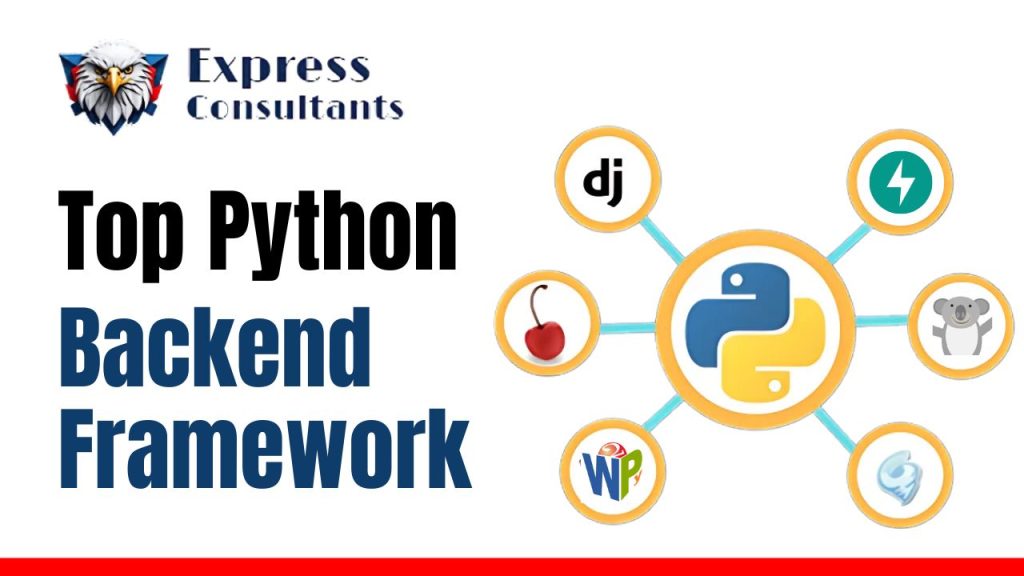
Top Python Backend Frameworks: How to Choose the Right One for Your Project
October 17, 2024Top Python Backend Frameworks: How to Choose the Right One for Your Project
“Did you know that Python ranks as one of the top three most popular programming languages in the world?” That’s right, Python has carved a space for itself in the realm of backend development, and with good reason. It’s not just the language’s simplicity and readability that make it so appealing—it’s also the powerful frameworks that come bundled with it. These backend frameworks are essential tools in a developer’s toolkit, and picking the right one for your project can make all the difference. In this article, we’ll explore the top Python backend frameworks and how to select the best one for your next big project.
What Is a Python Backend Framework, and How Does It Differ from Others?
So, what’s a Python backend framework anyway? Simply put, it’s a collection of modules and tools designed to help developers create the backend (server-side) part of web applications. While all frameworks aim to simplify the development process, Python’s frameworks are known for their versatility and ease of use. Unlike front-end frameworks, which handle the design and functionality of a website that users interact with, backend frameworks deal with the behind-the-scenes operations. Think of it as the brain of your app—the part that processes requests, communicates with databases, and handles all the heavy lifting.
The cool thing is that Python’s frameworks, compared to other languages, give you more flexibility. For example, Java frameworks are often seen as more rigid, while Python’s frameworks can adapt to a variety of needs—from lightweight apps to massive enterprise-level projects.
Top 10 Best Python Backend Frameworks
Now let’s dive into the juicy part—the top Python backend frameworks. Each of these has its strengths and use cases, so it’s important to know what you’re looking for when making a choice. Here’s the lowdown:
Django
- Easily one of the most famous Python frameworks. Django is all about speed, security, and scalability. It comes with everything you need to build a robust application right out of the box.
- Why Choose It?: If you’re working on a complex app with a lot of features, Django is perfect. It comes with built-in admin panels, ORM, and even security features like protection against SQL injection and cross-site scripting.
- Use Case: Ideal for e-commerce sites, social media platforms, and anything requiring rapid development.
Flask
- If Django is the “batteries-included” framework, Flask is its minimalist sibling. Flask is a micro-framework, meaning it’s lightweight and gives developers the freedom to plug in libraries as needed.
- Why Choose It?: For small projects or if you want complete control over the components in your app, Flask is the go-to.
- Use Case: Perfect for small-scale applications, RESTful APIs, or if you’re just starting with backend development.
FastAPI
- FastAPI is rapidly gaining popularity due to its speed (hence the name) and the ease with which you can build APIs. It’s asynchronous, which means it handles more requests at once compared to Flask and Django.
- Why Choose It?: Speed, simplicity, and fantastic documentation. FastAPI is also one of the best choices if you’re building a modern API with Python.
- Use Case: Highly suitable for APIs, especially those requiring asynchronous handling.
Tornado
- Tornado is unique in its non-blocking, asynchronous network I/O. It’s capable of handling thousands of connections simultaneously, making it great for real-time applications.
- Why Choose It?: If your project is focused on real-time functionality (e.g., live chat or video streaming), Tornado is ideal.
- Use Case: Real-time apps, such as web sockets, and live updates.
Pyramid
- Pyramid strikes a balance between the simplicity of Flask and the full-fledged features of Django. It offers flexibility while still being powerful enough for large applications.
- Why Choose It?: Flexibility and customization. Pyramid lets you scale as your project grows.
- Use Case: Great for applications that may start small but need the capability to scale over time.
Bottle
- Bottle is another micro-framework but even more minimal than Flask. It’s perfect for creating simple apps quickly, with only one file necessary to get it running.
- Why Choose It?: Simplicity and speed of development. You can create small applications in a matter of hours.
- Use Case: Quick prototypes or simple applications.
CherryPy
- CherryPy has been around for a while and offers a minimalist approach to web development. It’s often considered a bit old-school but remains a strong contender for small apps.
- Why Choose It?: It’s lightweight and great for projects that don’t need a lot of added libraries.
- Use Case: Ideal for small to medium-sized apps.
Hug
- Hug is all about APIs and being as lightweight as possible. It supports multiple API interfaces and is great for building fast and scalable APIs.
- Why Choose It?: If you’re focused entirely on API development, Hug offers an incredibly streamlined experience.
- Use Case: API-first applications and microservices.
Web2py
- Web2py comes with its own web-based IDE, which is pretty unique. It focuses on making the developer experience simple and productive.
- Why Choose It?: If you’re looking for an easy-to-use platform to build full-stack applications, Web2py is a solid choice.
- Use Case: Database-driven web apps with a simple workflow.
Sanic
- Similar to FastAPI, Sanic is an asynchronous web framework that’s incredibly fast and designed for performance.
- Why Choose It?: It’s perfect for projects that require high-speed handling of requests.
- Use Case: High-performance applications and web services.
Comparing the Frameworks: Which One Should You Choose?
Alright, so you’ve got a list of some top Python backend frameworks, but how do you know which one’s right for you? This is where things get a bit tricky. Choosing the right framework depends on what your project needs.
- Need something that’s quick and dirty? Go for Flask or Bottle. These micro-frameworks get the job done with minimal fuss.
- Building something big, secure, and needs a lot of built-in features? Django’s your guy.
- Real-time, speed-driven apps? Tornado and FastAPI are perfect fits.
Honestly, you’ve gotta ask yourself what’s most important—speed, flexibility, or out-of-the-box functionality?
And remember, no framework is perfect for every situation. Sometimes, the best one for the job might not even be the one you’re most comfortable with. But that’s part of the fun, right?
Benefits of Using Python Backend Frameworks
No matter which one you choose, the top Python backend frameworks bring several benefits to the table. First, Python itself is known for its readability and simplicity, which translates directly into the frameworks. They make code easier to write and maintain, even for large-scale applications. Also, with Python frameworks, you’ve got great community support, solid documentation, and a massive library of pre-built tools you can tap into.
Plus, since many of these frameworks are open-source, you’ve got an active group of developers constantly improving and updating them. This ensures you’re always working with the latest tools and technologies.
Conclusion
When it comes down to it, selecting the right framework is all about aligning the tool with the project’s needs. The top Python backend frameworks we’ve discussed each have their strengths, whether you need something lean like Flask or something powerful and comprehensive like Django.
So, what’s your next move? Try a few out, see what feels right, and build something amazing.
You may also like :-
TypeScript vs JavaScript: Which One Should You Choose?
MERN Stack vs MEAN Stack: Which One Should You Choose?
Ready to unlock your business's potential with custom software
Contact Us


